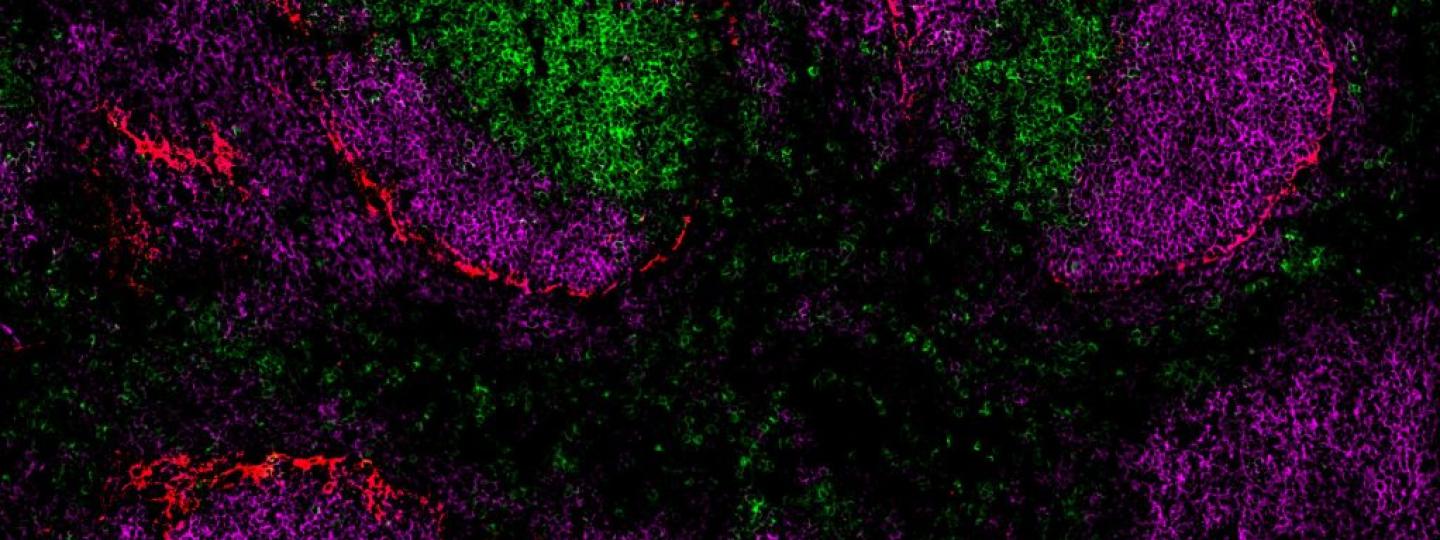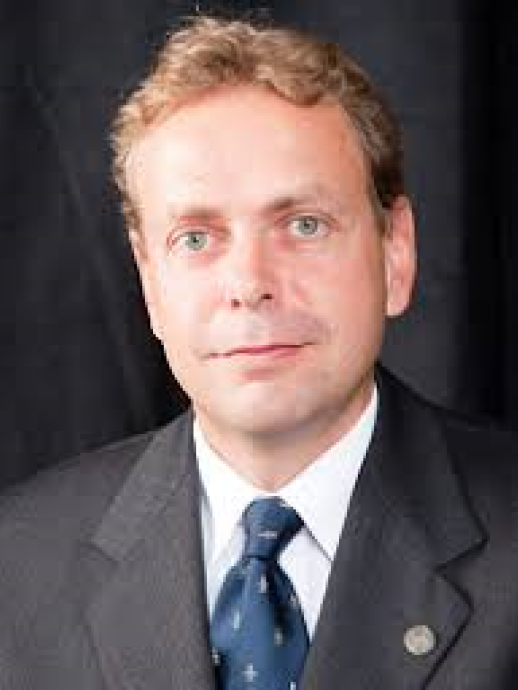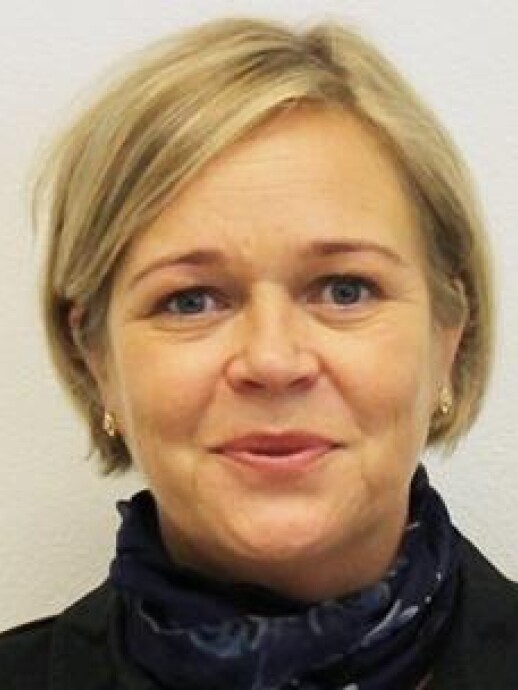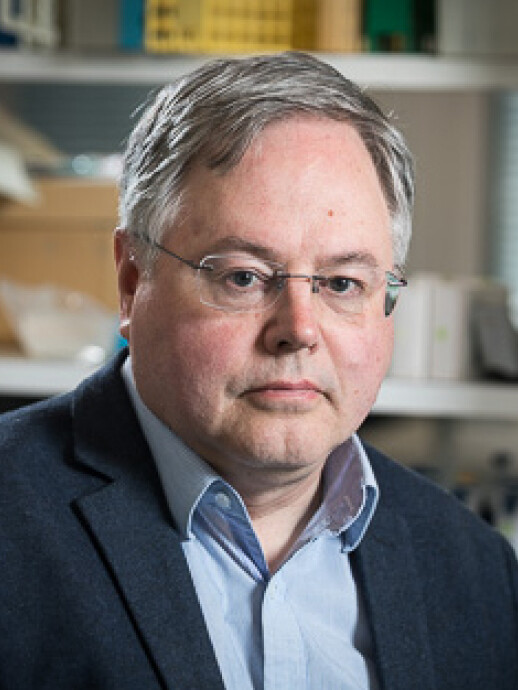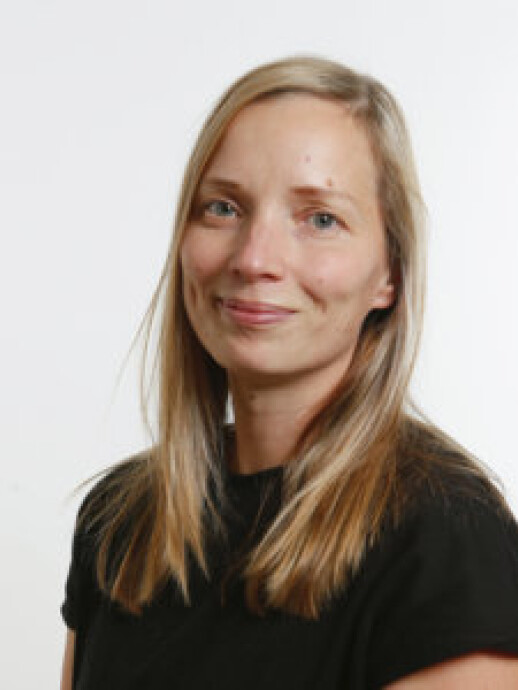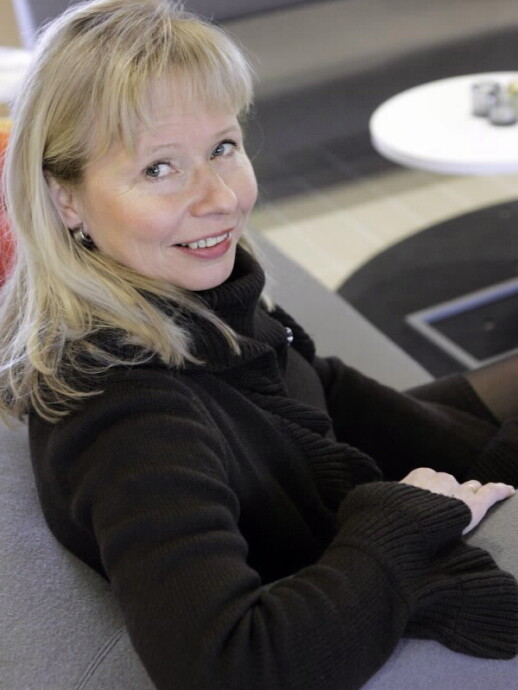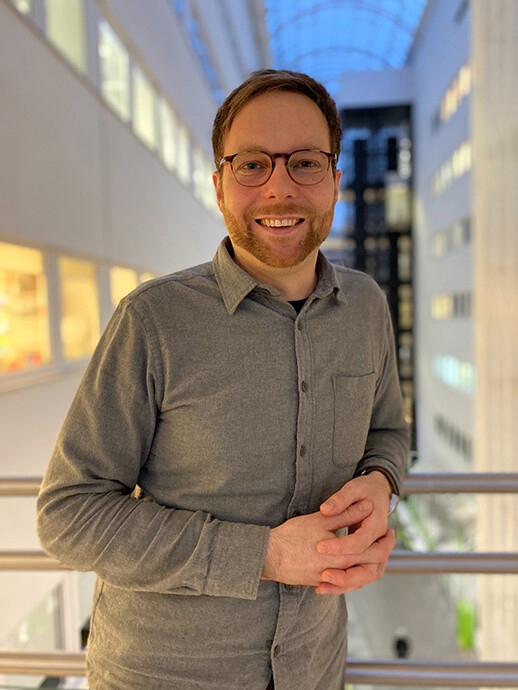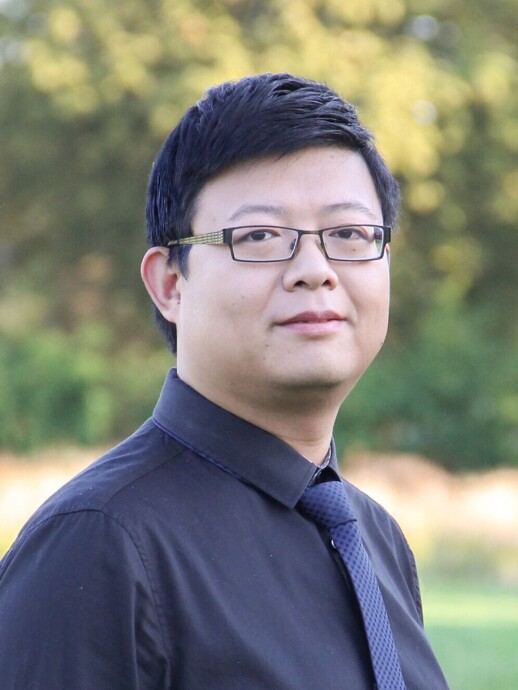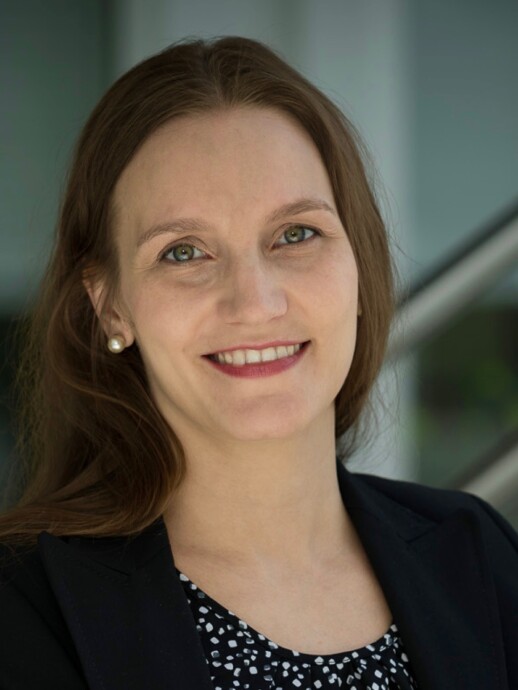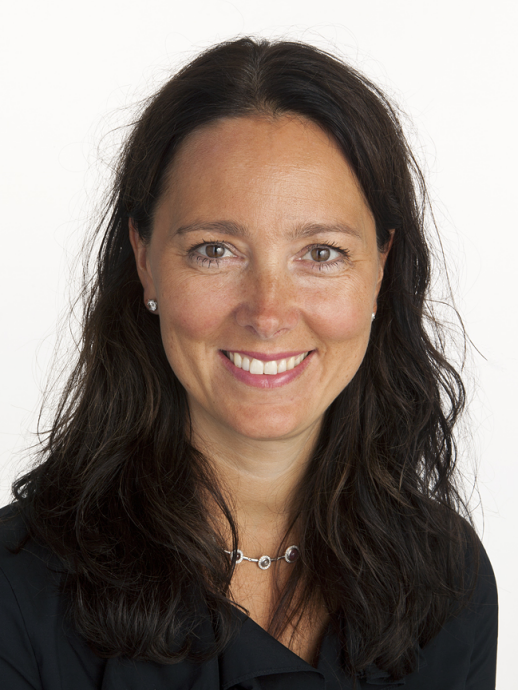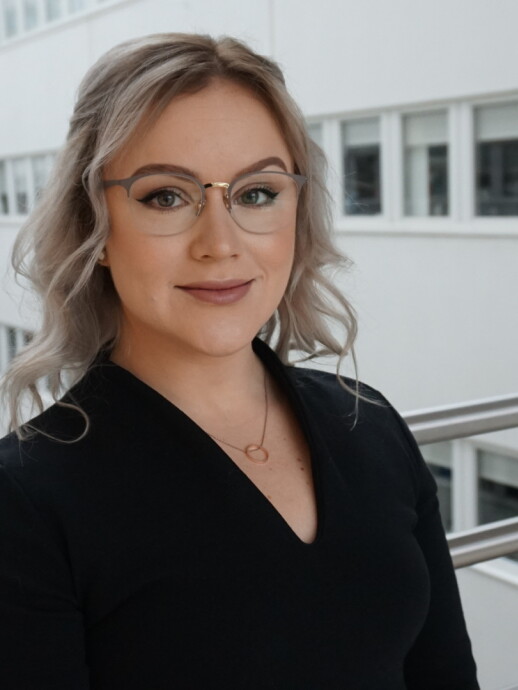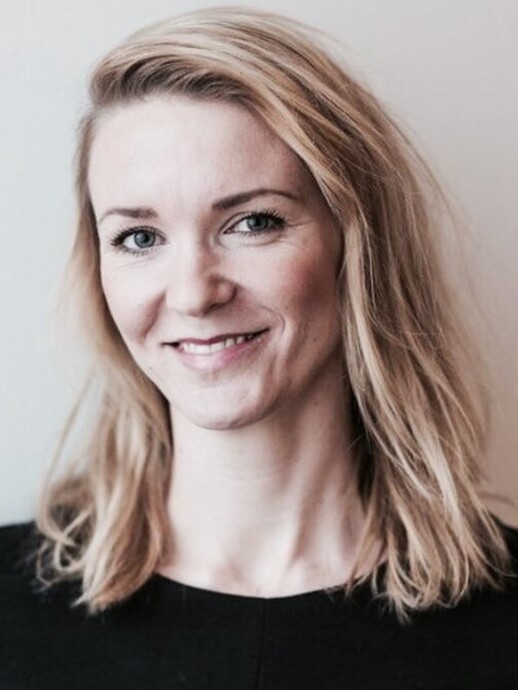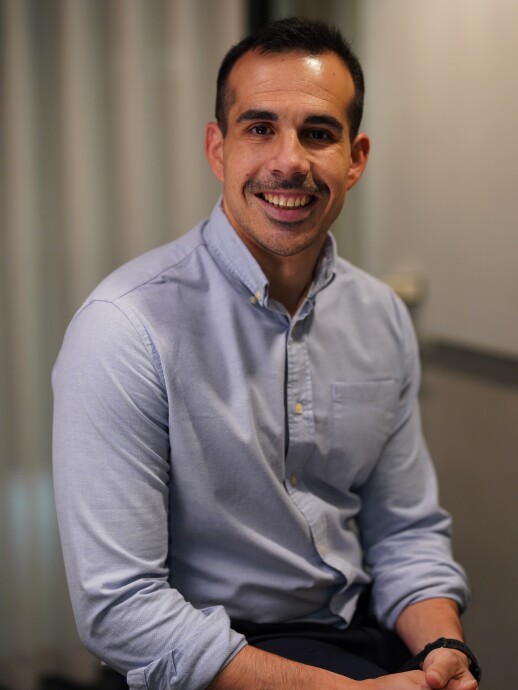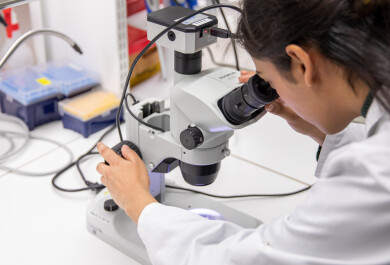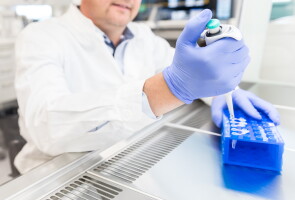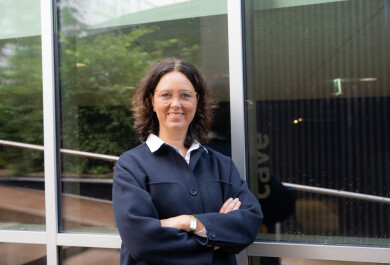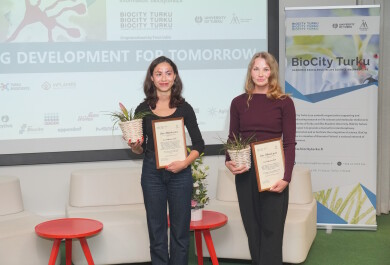MediCity on Turun yliopiston lääketieteellisen tiedekunnan BioCityssä sijaitseva moderni tutkimuslaboratorio, joka tarjoaa monipuolisen ja kansainvälisen ympäristön biolääketieteen huippututkimukselle. Olemme osa monikulttuurista Biocity Turun yhteisöä (katso esittelyvideo).
MediCityssä toimii biolääketieteen laitoksen, kliinisen laitoksen, PET-keskuksen, teknillisen tiedekunnan sekä InFLAMES-lippulaivan tutkimusryhmiä. Lisäksi MediCityssä on muita suoraan lääketieteellisen tiedekunnan yhteisten alla toimivia ryhmiä. Ryhmien tutkimus keskittyy immuunipuolustukseen ja tulehdustauteihin, kuvantamiseen ja syöpätutkimukseen. MediCityssä tehdään myös mm. rakennetutkimusta ja dynaamisen kombinatoriaalisen kemian tutkimusta. MediCityn tutkimusryhmien tutkimusaiheet kattavat koko kaaren perustutkimuksesta kliinisiin sovelluksiin.
MediCityssä työskentelee yli 20 itsenäistä tutkimusryhmää ja yhteensä n. 120 täysipäiväistä työntekijää. MediCity tarjoaa tutkijoille ja opiskelijoille innostavan ja korkeatasoisen tutkimus- ja koulutusympäristön, jonka trakoituksena on edistää biolääketieteellisen tutkimuksen translaatiota. Noin neljännes MediCityn tutkijoista (mukaanlukien 7 ryhmänjohtajaa) on kansainvälisiä asiantuntijoita. MediCityssä työskentelee myös kymmeniä väitöskirjatutkijoita. Oman alansa menetelmien kehittämisen lisäksi MediCityn tutkijat osallistuvat merkittävästi koko BioCityssä sijaitsevan tutkimusinfrastruktuurin (esim. kuvantaminen ja omiikkateknologiat) kehittämiseen.
Tutkimusryhmät
Principal Investigator
Francisco M. Acosta, PhD
Academy Research Fellow, MediCity Research Laboratory and Turku PET Centre, InFLAMES flagship
E-mail: fm.acostamanzano@gmail.com / facman@utu.fi
Follow on X: @fran_acostam
Description of Research
Harnessing the metabolic activity of human brown adipose tissue (BAT) has emerged as a promising strategy for combating cardiometabolic disease, particularly in the context of obesity. However, the heterogeneity, plasticity, and regulatory mechanisms of BAT in humans remain poorly understood. Our international and multidisciplinary group aims to characterize BAT plasticity and heterogeneity in humans using translational approaches integrated with single-cell omics technologies. Building on these insights, we investigate behavioural interventions (e.g., cold exposure, physical exercise) and pharmacological strategies that may enhance hBAT metabolic function and assess whether such changes improve cardiometabolic health. Finally, we explore the mechanisms that regulate human BAT - focusing especially on immune-adipocyte interactions - and we are developing advanced 3D in vitro models that more closely recapitulate the in vivo environment of this tissue.
Principal Investigator
Klaus Elenius
Professor of Medical Biochemistry,
Faculty of Medicine, University of Turku
MediCity Research Laboratories and Turku Center for Biotechnology
University of Turku and Åbo Akademi University
Cancer Research Laboratories, FICAN West
klaus.elenius [at] utu.fi
Description of Research
Our goal is to understand how receptor tyrosine kinases (RTK) regulate the pathogenesis of human diseases, such as cancer. This information is needed for the development of molecularly targeted therapies. To recognize aberrations of RTK signaling in diseased tissue our laboratory also works on the molecular mechanism by which RTKs control normal processes, such as embryonic development. The work mainly focuses on the ErbB family of RTKs. Our laboratory has contributed to the field by e.g. by characterizing novel RTK signaling mechanisms, by identifying novel ErbB4 isoforms, and by determining the role of ErbBs and their ligands in angiogenesis.
Current Topics
• Screens for predictive RTK mutations
• Novel RTK signaling mechanisms
• Development of preclinical models for development novel RTK inhibitors
• Sequencing of RTK inhibitor drug administration with cytotoxic agents
• In vitro “basket trials” with ErbB inhibitor drugs
• RTK signaling in angiogenesis and cardiovascular diseases
• RTKs in pediatric malignancies
• Biological role of novel ErbB4 isoforms in diseases and development
Principal Investigator
Senior Researcher, Turku PET Centre (University of Turku)
Adjunct Professor, Dept. Clinical Medicine (University of Turku)
tovgro [at] utu.fi
Description of Research
Our translational research focuses on evaluating and validating PET tracers for imaging the tumor microenvironment. We are especially interested in approaches for determining the level of radioresistance in solid tumors that affect radiotherapy treatment outcomes in cancer patients. Such tracers can be utilized for treatment planning and follow-up purposes in clinical settings. Another objective is to re-evaluate some existing tracers for their possible use as cancer imaging tools or to measure changes in cancer-dependent metabolism pathways on a whole-body level, which might affect treatment outcomes. We combine PET technology with state-of-the-art technologies for molecular biology utilizing cell lines, tumor models, and patient-derived samples.
Principal Investigator
Pauliina Hartiala
dosentti, kirurgia
erikoistutkija Sr., MediCity
InFLAMES Lippulaiva
MD, PhD, Plastiikkakirurgi
e-mail: pauliina.hartiala@utu.fi
Tutkimuksen kuvaus
Ryhmämme tutkii rintasyöpään liittyvän lymfedeeman patofysiologiaa, ennustamista ja hoitoa. Normaalin ja lymfedematoottisen ihon ja rasvakudoksen kudoskoostumusta ja geeniekspressiota tutkitaan erityisesti immuunisoluissa. Käytämme yksisolu-RNA-sekvensointia, virtaussytometriaa ja immunofluoresenssivärjäystä saadaksemme kattavan kuvan siitä, mitkä solu- ja molekyylivälittäjät ovat vastuussa rasvan kertymiselle ja fibroosille lymfedeemassa. Luonnehdimme myös muutoksia, jotka tapahtuvat endoteelisoluissa lymfaturvotuksen edetessä. Meidän tavoitteena on selvittää lymfedeeman patofysiologiaa ja luoda pohjaa uusien hoitomenetelmien kehittämiselle tähän krooniseen ja elämänlaatua heikentävään sairauteen.
Principal Investigator
Jyrki Heino
Scientific Director, BioCity Turku (BioCity Turku)
Professor, Biochemistry (Department of Biochemistry)
jyrki.heino [at] utu.fi
Description of Research
Our research group is studying the structure¬–function relationship of the collagen receptor integrins. The most important methods used include the production of recombinant protein domains, functional assays and mutations of the domains, bioinformatics as well as the expression and analysis of the full-length receptor proteins on cell surface. This has lead to a project aimed at development of small molecular inhibitors for collagen receptors.
In addition to the structural work we are also interested in integrin signaling, especially atypical signaling mechanisms, including low avidity integrin–ligand interaction and signaling by nonactivated integrins. Most recently, we have studied the role of collagen receptor signaling in prostate cancer and the consequences of post-translational modifications, such as citrullination, of the integrin ligands in inflammation In these experiments we use the general methods of molecular cell biology, imaging by confocal microscopy and proteomics. In a separate project we have developed new software for quantitative bioimaging (BioImageXD).
Group Members
Jarmo Käpylä, Senior Scientist, Ph.D., Docent
Pekka Rappu, Postdoctoral Researcher
Johanna Jokinen, Postdoctoral Researcher
Elina Siljamäki, Postdoctoral Researcher
Anna-Brita Puranen, Doctoral Candidates
Marjaana Ojalill, Doctoral Candidates
Salli Keinänen, Doctoral Candidates
Maria Tuominen, Laboratory Technician
Noora Virtanen, Undergraduate Student
Ville Jokinen, Undergraduate Student
Principal Investigator
PhD, Manager of Preclinical in vivo PET Imaging
Preclinical Imaging Unit, Turku PET Centre (University of Turku)
jatta.helin [at] utu.fi
Description of Research
The main goal of our research is to provide quantitative modeling tools that enable kinetic analyses of animal PET imaging data. Tracer kinetic models can be exploited to measure blood flow, membrane transport, metabolism, and ligand-receptor interactions noninvasively and quantitatively in various animal disease models tailored for metabolic disorders, and neurodegenerative and neuropsychiatric diseases. Ongoing projects aim at translating preclinically achieved data into human PET imaging protocols to be used in research and clinical settings.
Principal Investigator
Maija Hollmen
Academy Research Fellow, Department of Clinical Medicine (Department of Clinical Medicine),
Adjunct Professor, MediCity Research Laboratory (Faculty of Medicine)
maijal [at] utu.fi
Description of Research
Our research exploits a unique scavenger receptor Clever-1, expressed on a subpopulation of immunosuppressive macrophages, to alleviate tumor related inflammation and develop Clever-1 as a companion therapeutic, diagnostic, and prognostic biomarker to treat and identify patients under immunosuppression. This involves the use of in vivo tumor models and sophisticated immunological assays with cutting-edge technology and state-of-the-art imaging combined with fresh human cancer patient material to elucidate the function of Clever-1 in controlling macrophage mediated local and systemic immune responses. Our results potentially have a high impact in understanding the mechanism of macrophage-mediated immunosuppression in cancer and promoting anti-Clever-1 immunotherapy into clinical trials where it may have benefits in comparison with currently available immune activating drugs.
Principal Investigator
Sirpa Jalkanen
Professor, Academician
Institute of Biomedicine
sirpa.jalkanen [at] utu.fi
Description of Research
The overall goal of our research is to elucidate the mechanisms regulating the traffic of leukocytes and cancer cells in the body. Harmful leukocyte migration into the joints in rheumatoid arthritis and into the pancreas in diabetes are examples of diseases where leukocytes cause extensive destruction. These inflammatory diseases can be cured by inhibiting leukocyte trafficking. Also, metastasising malignant cells often use the same mechanisms as leukocytes when extravasating from blood to different organs or migrating via the lymphatics into distant sites. The results obtained can be utilized when new types of drugs are developed to treat harmful inflammations and cancer.
Principal Investigator
Jianwei Li
Senior Research Fellow, MediCity, PhD, Group Leader
jianwei.li [at] utu.fi
Description of Research
Molecular Systems Engineering is an emerging field by understanding the fundementals of molecular properties and dynamics in synthetic complex systems, and exploring sophisticated functions for advanced applications in biomedicine, materials and energy. Our laboratory uses the tools of dynamic combinatorial chemistry (DCC), supramolecular chemistry and computer chemistry to fabricate the framework of complex chemical systems, investigates the self-assembly in such systems and uncovers the working principles at molecular level behind them. We have learned that self-assembly can not only direct the formation of beautiful and intriguing structures i.e. catenanes and “Russian-doll”-like supramolecular architectures, but also promote the molecules to make copies of themselves as the living matters in nature. Currently we are trying to extend the board of DCC into the fields of materials science, enzymology and biology by three lines of research: 1) dynamic combinatorial biomaterials for controlling cell behaviors; 2) enzyme-directed DCC; and 3) DCC in vivo.
Principal Investigator
Kari J. Kurppa, Senior Researcher, Institute of Biomedicine
kjkurp@utu.fi
Description of Research
Our aim is to understand the means cancer cells use to develop resistance to cancer therapies. Our special focus are the mechanisms that enable the establishment of minimal residual disease, or govern the maintenance of residual tumors following targeted cancer therapy. The overarching goal of our research is to develop rational combination strategies that will extend the long-term efficacy of clinically used cancer therapies.
While targeted therapy has transformed the treatment of cancer, the long-term efficacy of these strategies is hampered by acquired drug resistance. In many cases, clinical drug resistance is preceded by minimal residual disease (MRD) state, where residual tumors stay dormant for an extended period of time. Emerging evidence indicates that the establishment of MRD is mainly regulated by non-genetic mechanisms, as cancer cells adapt to treatment by acquiring new phenotypic states that no longer depend on the targeted oncogene. These slow-cycling drug tolerant cells can regain proliferative state upon drug withdrawal or acquisition of additional resistance mechanisms, and as such serve as a reservoir of dormant cells capable of re-initiating the growth of a drug resistant tumor. Understanding the mechanisms underlying the establishment or maintenance of minimal residual disease would enable the development of rational combination strategies aimed to prevent or limit residual disease, leading to prolonged survival of cancer patients.
Principal Investigator
InFLAMES Group Leader, Adjunct Professor, Institute of Biomedicine
pieta.mattila [at] utu.fi
Description of Research
We investigate the regulation of B lymphocyte activation that mounts specific and highly effective antibody responses against pathogens. However, if lymphocyte activation is defected, we face pathological conditions such as autoimmunity or lymphoma. In our research, we integrate advanced light microscopy and proteomic approaches with cellular and in vivo models, to gain novel understanding on the cell biological phenomena of B cell activation and immune responses.
Principal Investigator
Alexander Mildner, Associate Professor
alexander.mildner [at] utu.fi
Description of Research
Tissue resident macrophages are long-lived cells that are distributed throughout the body and migrate into the tissue during embryogenesis. They are specialized in ingesting and processing dead cells, debris and foreign materials, and in the recruitment of other immune cells – like monocytes – to sites of injury in response to inflammatory signals. Monocytes, on the other hand, represent short-lived cells that can be found in the peripheral circulation. Traditionally, it was assumed that monocytes represent an intermediate stage, linking mononuclear phagocyte precursors in the bone marrow with terminally differentiated tissue resident macrophages. However, this concept seems to hold true only for certain tissues. In most of the cases, embryo-derived tissue macrophages are endowed with an intrinsic self-renewal program to maintain homeostasis, while monocyte descendants are devoid of this capacity. Instead, monocytes are highly plastic cells and can differentiate – depending on the cellular context – into various cell types with fundamental different functions like effector monocytes, monocyte-derived dendritic cells and monocyte-derived macrophages.
The transcription factor C/EBPβ is expressed in cells of the myeloid lineage, especially in monocytes, macrophages and dendritic cells. Recently, we applied epigenetic approaches to identify C/EBPβ as one of the main regulators of monocyte and Alveolar macrophage development under physiological conditions. Deficiency of C/EBPβ in mice let to a complete absence of Ly6C- monocytes due to impaired induction of the monocytic survival factor Nr4a1. In Alveolar macrophages, C/EBPβ controlled the expression of a lipid catabolic program.
We are currently investigating the differentiation of myeloid cells under steady state as well as pathological conditions such as autoimmunity in various tissues using epigenetic approaches including ATACseq, ChIPseq and high resolution immune profiling like scRNA-Seq. The central goal of our laboratory is to identify new factors that are involved in the differentiation of monocytes and macrophages under pathological conditions. We hope to manipulate the fate and activation status of macrophages and thereby beneficially influence disease progression.
Current topics
Monocytes differentiation and function during neuroinflammation
Microglia heterogeneity
Tissue-specific function of macrophages
Group's website / Twitter @MildnerLab / Research Gate
Principal Investigator
Maxwell W.G. Miner (PhD)
Preclinical Imaging Project Manager and Senior Researcher, Turku PET Centre
maxwell.miner [at] utu.fi
Description of Research
We work in the development and characterization of novel positron emission tomography (PET) radiotracers to investigate a wide variety of disease targets and collaborate with a wide variety of groups with varying interests. Our main research lines focus on oncology (primary neuro-oncology) but include cardiology and heart disease, inflammation, disease progression, metabolism and exercise physiology. radio tracer, other drug or altered metablomics and pharmacokinetic modelling are often a significant parameter we investigate in our research.
We also work on developing ways to improve imaging capabilities by designing and testing 3D-printed phantom subjects for PET, SPECT, CT and MRI imaging modalities testing in both preclincal and clinical camera models.
Principal Investigator
Adjunct Professor, Department of Clinical Medicine, Senior Researcher at TCSM, Institute of Biomedicine
mihnak@utu.fi
Description of Research
Main goal of our research is to find a solution for bone diseases in elderly population, such as osteoarthritis and osteoporosis. Our research is aiming at multidisciplinary collaborations between medicine, cell biology and materials science.
My current research interest includes:
- Bio-inspired biomaterials to enhance bone regeneration through the manipulation of bone cells (osteoblasts, osteocytes and osteoclasts)
- New parameters for the evaluation of bone quality using knowledge of materials science
- Mechanism of osteolysis in aseptic loosening
- Engineering of bone to prevent osteoporosis
Keywords: Biomaterials, Tissue Engineering, Bone regeneration, Osteoblasts, Osteocytes, Osteoclasts, Osteolysis
Group members
Uruj Sarwar, Doctoral Candidate
Jorgan Sobrepena, Master Student
Leire Bergara Muguruza, Undergraduate Student
We are looking for students (undergraduates, masters, Ph.D. candidates all welcome)! Please feel free to contact/ visit us.
Selected Publications
Tuukkanen J, Nakamura M. Hydroxyapatite as a nanomaterial for tissue engineering and drug therapy. Curr Pharm Design, 2017: 23(26), 3786-3793.
Nakamura M, Hori N, Ando H, Namba S, Toyama T, Nishimiya N, Yamashita K. Surface Free Energy Predominates in Cell Adhesion to Hydroxyapatite through Wettability. Mater Sci Eng C 2016: 62, 283-292.
Nakamura M, Hiratai R, Hentunen T, Salonen J, Yamashita K. Hydroxyapatite with High Carbonate Substitutions Promotes Osteoclast Resorption through Osteocyte-like Cells. ACS Biomater Sci Eng 2016: 2 (2), 259-267.
Nakamura M, Hentunen T, Salonen J, Nagai A, Yamashita K. Characterization of bone mineral-resembling biomaterials for optimizing human osteoclast differentiation and resorption. J Biomed Mater Res A, 2013: 101A (11), 3141-3151.
Nakamura M, Soya T, Hiratai R, Nagai A, Hashimoto K, Morita I, Yamashita K. Endothelial cell migration and morphogenesis on silk fibroin scaffolds including hydroxyapatite electret. J Biomed Mater Res A 2012: 100A, 969-977.
Principal Investigator
Professor, InFLAMES Flagship
cecilia.naucler@utu.fi
Description of Research
The long-term goal of our projects is to further understand how cellular metabolism control immune activation, cancer cell growth, and the life cycle of human cytomegalovirus (HCMV) that appears to be closely involved in the pathogenesis of inflammatory disease and cancer. We hope that this will allow us to find new treatment strategies for many of our common diseases. Our research is carried out at Turku University, MediCity Research Laboratory and Karolinska Institutet.
HCMV is a common virus, infecting 70-90% of the worlds population. This virus is considered harmless for healthy individuals but may cause severe disease in immunocompromised patients. Emerging evidence also imply a role of this virus in inflammatory diseases and cancer. HCMV is reactivated by inflammation, can drive inflammatory processes and is often found in inflamed tissue specimens obtained from patients with inflammatory diseases such as SLE, rheumatoid arthritis, inflammatory bowel disease, cardiovascular diseases and aortic aneurysms, while rarely detected in healthy tissues. HCMV is also commonly found to be active in tumors of different origin such as glioblastoma, neuroblastoma, medulloblastoma, breast, colon, prostate and ovarian cancer. Both primary tumors as well as metastases are virus positive, while healthy tissues surrounding tumors and metastases are virus negative. We are currently studying the effect of anti-HCMV therapy in 220 glioblastoma patients in a randomized trial, VIGAS2. Retrospective analyses of so far treated patients (139 patients) indicate substantial prolonged survival time in patients receiving anti-viral therapy, which suggest a potential role of this virus in cancer.
Activation of immune cells depend on alterations in cellular metabolism; i.e the Warburg effect, which is also essential for cancer cells to grow. HCMV establishes the Warburg effect in infected cells, which appears to be essential for reactivation of latent HCMV and virus production Thereby our studies of viral regulation of cellular metabolism unifies the many diseases associated with HCMV. Although the metabolic alterations to the Warburg effect is essential for inflammation and cancer, it is not known how cells switch from normal metabolism to the Warburg effect. We have used HCMV as a tool to try to understand the underlying mechanisms of the Warburg effect in immune cells and cancer cells. We made unexpected insights into how cells with a normal metabolism switch to the Warburg effect, which allowed us to identify metabolic inhibitors that we are now testing how they affect immune cell activation and cancer cell growth.
Group Members
Hatem Abouguendia, Doctoral Researcher
Iqra Khawaja, Doctoral Student
Mohammad Pirouzfar, Doctoral Student
Päivi Ylä-Anttila
Shaghayegh Hasanpour, Doctoral Student
Principal Investigator
Vilhelmiina Parikka, MD, PhD
Senior Research Fellow, Paediatrics and Adolescent Medicine, Medicity Research Laboratory and Turku PET Centre
vilpar [at] utu.fi
Description of Research
The main interest of our research group is in pathophysiological mechanisms and treatment options for neonatal hypoxic-ischemic injury. The research project aims to provide deeper understanding of the pathological processes behind the brain injury, to identify tools for the early recognition of the injury and to develop new clinically relevant strategies for the treatment of this group of vulnerable infants. The research group has a special interest in the role of inflammation and endothelial injury in the pathophysiological process of the brain injury. The role of PET imaging scans as an early marker for metabolic changes and inflammation in a preclinical model of neonatal hypoxic-ischemic encephalopathy is actively studied.
Principal Investigator
Marko Salmi, MD, PhD
Professor of Immunology, Institute of Biomedicine
Medicity Research Laboratory
InFLAMES Flagship
e-mail: marko.salmi@utu.fi
Tel: +358-50-3385678
Description of Research
Leukocyte migration from the blood and lymph into tissues and transport of antigens into secondary lymphoid organs are critical for the generation of normal immune responses. Dysregulation of these dynamic processes contribute to the pathogenesis of all inflammatory diseases and several other diseases, such as cancer. We study the molecular mechanisms and functional implications of antigen and leukocyte traffic in the body. We are interested in defining the routes and mechanisms by which antigens enter the lymph node parenchyma via the lymphatic vasculature. We elucidate the role of stromal cells of draining lymph nodes in antigen handling. We also study the effects of tissue niche on the plasticity and functions of macrophages and other myeloid cells. Moreover, we analyze therapeutic potential of the new leukocyte trafficking molecules we have identified on blood and lymphatic vessels (e.g. vascular adhesion protein-1 (VAP-1), CD73, stabilin-1, plasmalemma vesicle associated protein (Plvap)) in inflammation and cancer. As a separate line of research, we study the value of leukocyte and endothelial cell subsets and soluble inflammatory mediators (e.g., cytokines) as biomarkers of disease in population and patient cohorts.
Principal Investigator
Akira Takeda, PhD
Academy Research Fellow,
MediCity Research Laboratory,
InFLAMES flagship
e-mail: akitak@utu.fi
Tel. +358 29 450 4383
Description of Research
Although immune cells play a critical role in human diseases such as infection and cancer, structural cells including endothelial and stromal cells are also crucial for maintaining the function of the immune cells. Recent single-cell technologies showed multiple heterogenous subsets in structural cells that have not been considered before. The aim of our group is (1) to find unrecognized heterogeneous structural cell subsets in human organs including lymphoid organs and tumors using single-cell technologies, and (2) to find the new molecular mechanism between heterogeneous structural cells and immune cells in health and disease.
Principal Investigator
Associate Professor, Turku PET Centre (University of Turku and Turku University Hospital)
kianvi [at] utu.fi
Description of Research
The main focus of our research is to understand the function of human brown adipose tissue in health and in metabolic disorders. Current projects are focused on ascertaining the crosstalk between the gut microbiota/products and the immune system with brown adipose tissue function in humans.
This project functions under the framework of the INFLAMES flagship, funded by the Academy of Finland, and aims to: i) ascertain how the infiltrated immune cells within brown adipose tissue modulate its function, and ii) ascertain the mechanisms by which an inflammatory environment may induce brown adipose tissue dysfunction.
Principal Investigator
Anton Zavialov
Senior Research Fellow, Joint Biotechnology Laboratory (JBL)
anton.zavialov@utu.fi
Description of Research
We work in the field of structural biology and structure-based drug design. Our main methods are x-ray crystallography and cryo-electron microscopy. The main focus of our research is the unraveling of molecular mechanisms governing the interplay between microbial pathogens and their hosts, and the exploitation of these finding in medicine. We are particularly interested in host-pathogen interactions during the early steps of infection: bacterial attachment and biofilm formation mediated by fimbrial adhesins and host tissue invasion mediated by the Type III secretion system. Blocking these steps could prevent infections caused by antibiotic-resistant pathogens. Another line of our research explores the intricate cell signaling mechanism of the novel growth factor-enzyme, adenosine deaminase type 2 (ADA2). This study paves the way for the development of novel means to treat blood cancers and vascular disorders, including a genetic disease called deficiency of ADA2 (DADA2). In addition, we develop a novel ADA-based immuno-oncological therapy of advanced cancers.
Group Members
Minna Tuittila, Postdoctoral Researcher
Sari Paavilainen, Senior Researcher
Henri Malmi, Doctoral Candidate
Maksym Skaldin, Doctoral Candidate
Vladimir Zav’yalov, Visiting Professor
Daria Nedorezova, Project researcher
Nour Mustafa, Project researcher
Selected publications
Skaldin M, Tuittila M, Zavialov And. V & Zavialov Ant. V (2018) Secreted bacterial adenosine deaminase is an evolutionary precursor of adenosine deaminase growth factor. Molecular Biology and Evolution, 35:2851-2861.
Pakharukova N, McKenna S, Tuittila M, Paavilainen S, Parilova O., Malmi H, Matthews S. & Zavialov AV (2018) Archaic and alternative chaperones preserve pilin folding energy by providing incomplete structural information. Journal of Biological Chemistry, 293(44):17070-17080.
Pakharukova N, Tuittila M, Paavilainen S, Malmi H, Parilova O, Teneberg S, Knight S & Zavialov AV‡ (2018) Structural basis for Acinetobacter baumannii biofilm formation. Proc Natl Acad Sci U S A 115, 5558-5563
Gurung J, Amer A, Francis MK, Costa TRD, Chen S, Zavialov AV & Francis MS (2018) Heterologous Complementation Studies With the YscX and YscY Protein Families Reveals a Specificity for Yersinia pseudotuberculosis Type III Secretion. Frontiers in cellular and infection microbiology 8, 80.
Pakharukova N, Roy SP, Tuttila MT, Paavilanen S, Ingars A-K, Skaldin M, Lamminmäki U, Härt T, Teneberg S. & Zavialov AV (2016). Structural basis for Myf and Psa fimbriae-mediated tropism of pathogenic strains of Yersinia for host tissues. Molecular Microbiology, 102, 593–610.
Pakharukova N., Garnett G, Tuittila MT, Paavilainen S., Diallo M, Xu Y., Matthews S. and Zavialov AV (2015) Structural insight into archaic and alternative chaperone-usher pathways reveals non-classical mechanism of pilus biogenesis. PLoS Pathogens, 11:e1005269.
Amer A, Gurung J, Costa T, Zavialov AV, Forsberg Å & Francis M (2015) YopN and TyeA hydrophobic contacts required for regulating Ysc-Yop type III secretion activity by Yersinia pseudotuberculosis. Frontiers in cellular and infection microbiology, 6:66.
Berry A, Yang Y, Pakharukova N, Garnett J, Lee W, Cota E, Marchant J, Roy S, Tuittila M, Liu B, Inman K, Ruiz-Perez F, Mandomando I, Nataro J, Zavialov AV and Matthews S (2014) Structural insight into host recognition by aggregative adherence fimbriae of enteroaggregative Escherichia coli. PLoS Pathogens, 10, e1004404
2025
Suomen Akatemialta Turun yliopistolle lähes 20,4 miljoonaa euroa akatemiahankkeisiin ja akatemiatutkijoille. Onnea Medicityläisille ja muillekin!
- Kari Kurppa (biolääketieteen laitos): Hoidon aiheuttama adaptiivinen immunosuppressio EGFR-mutaatiopositiivisessa keuhkosyövässä, 599 271 e
- Pieta Mattila (biolääketieteen laitos, InFlames-lippulaiva): Solunsisäiset kalvorakkulat B-solujen aktivaatiossa ja immuniteetissa, 600 000 e
- Marko Salmi (biolääketieteen laitos, InFlames-lippulaiva): Imusolmukkeen siivilöintitoimintojen ymmärtäminen ja hyödyntäminen, 599 997 e
- Francisco Miguel Acosta Manzano (InFlames-lippulaiva, valtakunnallinen PET-keskus): Fyysisen harjoittelun aineenvaihdunnalliset vaikutukset ihmisen ruskean rasvakudoksen toimintaan terveillä ja lihavilla koehenkilöillä, 829 421 e
18.6 Dissertation defence Richard Aarnio
Akira Takeda on valittu IUIS 2025 Rising Stars -ohjelmaan Meet the IUIS 2025 Rising Stars! [12.6]
28.5 Dissertation defence Dawei Qi
Hartiala Lab: Lymph node transfer reduces arm swelling after breast cancer surgery [Inflames 18.3]
Dissertation defence (Medical Microbiology and Immunology): MSc Karolina Losenkova Mingeaud (Sirpa Jalkasen tutkimusryhmä) [UTU 7.3]
Yhteispohjoismaiselle aivosyövän tutkimushankkeelle neljän miljoonan euron apuraha (Cecilia Nauclerin tutkimusryhmä) [UTU 5.2]
2024
ImmuDocs-tohtorikoulutuspilotin projektihaku oli auki 23.9.-6.10.2024. Haku sai 30 pilottiprojektiehdotusta, joista 13 valittiin immunologisten saavutusten perusteella. Medicityn tiloissa työskentelivästä seuraavat ryhmät pääsivät mukaan:
- Vilhelmiina Parikka, Turku University Hospital/MediCity
Inflammatory biomarkers in neonatal hypoxic-ischemic brain injury - Cecilia Soderberg-Naucler, Institute of Biomedicine
Evaluation of immune based therapies for cytomegalovirus positive cancer forms [UTU 11.10]
Väitös (Kurppa Lab): Väittelijä selvitti epäselvän syöpägeenin potentiaalia täsmälääkehoidon kohteena jo olemassa olevilla lääkkeillä (Väitös: FM Veera Ojala, 4.10.2024, lääketieteellinen biokemia ja genetiikka [UTU 4.10]
Novo Nordisk -säätiöltä yli 2,2 miljoonaa euroa apurahoja Turun yliopiston tutkijoille [UTU 1.10.]
Saajien joukossa MediCityssä työskentelvät:
- Apulaisprofessori, InFLAMES-ryhmänjohtaja Alexander Mildner: Attenuating obesity pathogenesis via macrophage lipid catabolism modulation, DKK 2.931.000 (n. 393 046 €)
- Professori, BioCity Turun johtaja Klaus Elenius: Overcoming Cancer drUg Resistance by targeting ERBB3 (CURE), DKK 5.981.741 (n. 802 149 €)
Invitation to Cancer Researchers After Work Event on September 10th at 15:00 (MedD / Tiedonkolu) [5.9.]
Under the motto "Get out of your office and meet your research community", the Turku Cancer Research Society would like to invite all its members and cancer researchers to the Cancer Researchers After Work event on September 10th from 15:00 to 18:00 at Medisiina D, Tiedonkolu.
During the event, we will introduce new basic and medical cancer researchers on the Turku campus. In addition, you will have the chance to interact with other researchers in an informal environment and play a Mystery 🔍 game while enjoying snacks and drinks sponsored by BioNordika.
Everyone is welcome, including students, researchers, and medical doctors. Please, register your attendance using this link https://link.webropolsurveys.com/EP/CF54020B9DCF24FE
Program:
15.00 Opening words on behalf of Turku Cancer Society: Kari Kurppa/Pilvi Riihilä
15.05-15.35 Sakari Hietanen (Docent, Faculty of Medicine.Obstetrics and Gynecology
15.35-15.50 New Principal Investigators on campus: Jonna Alanko
15.50-16.05 New Platforms for cancer research: Ilkka Paatero
16.05-18:00 Discussion, games and networking!
- Pauliina Hartiala, University of Turku/VARHA
Targeting type 2 innate lymphoid cells to treat inflammation and fibrosis in lymphedema - Maija Hollmén, MediCity Research Laboratory
CRISPR screening of primary human macrophages to discover novel druggable regulators of antitumor effector functions - Sirpa Jalkanen, MediCity Research Laboratory
Retinal Inflammation: the role of ATP-adenosine pathway - Pieta Mattila, Institute of Biomedicine
Mechanisms of antigen presentation in B cells - the role of Septin cytoskeleton - Marko Salmi, MediCity Research Laboratory
Fibroblastic reticular cells in immunology: new regulators, new locations - Akira Takeda, MediCity Research Laboratory
Combined single-cell imaging and proteomic analysis to unveil human myeloid cell heterogeneity
Turun yliopiston ensimmäiset ImmuDocs-tohtorikoulutuspilotin projektit on valittu [8.4]
Valittujen joukossa:
Akira Takeda, MediCity, Unveiling macrophage subsets in metastatic lymph nodes and their impact on tumor immunity
Marko Salmi, MediCity, Lymphatic sinuses of draining lymph nodes
Alexander Mildner, MediCity/Institute of Biomedicine, Role of PPARg1 and PPARg2 in tissue-resident macrophage maintenance
Pieta Mattila, Institute of Biomedicine, Extracellular vesicles as novel regulators of the immune response and B lymphocyte activation
Sirpa Jalkanen, MediCity, Immune landscape in breast cancer – does it matter?
Maija Hollmén, Medicity, Dual-targeting of myeloid malignancies and their tumor microenvironment with bexmarilimab
ImmuDocs aikoo kouluttaa immunologia-alan osaajia [18.12.23, InFLAMES]
Elimistön syöjäsolujen tutkimisesta tuli Alexander Mildnerin intohimo [20.3]
2023
Uudesta lääkeaineesta löytyi uusi ominaisuus, esti koeoloissa okasolusyövän etenemistä [8.11]
Diana Lehotina voitti parhaan posterin palkinnon 49th Annual Meeting of the Scandinavian Society of Immunology seminaarissa [7.6]
Sakari Alhopuron säätiöltä apurahoja lääketieteen ja luonnontieteiden tutkijoille [30.5]
- Fair-Mäkelä Ruth, Turun yliopisto, InFLAMES-lippulaiva, MediCity, 60 000 € (jatkorahoitus), ”PLVAP-sensorin merkitys imusolmukkeen suodatustoiminnon säätelyssä”
Turun yliopistoon 11 uutta biotieteiden, terveyden ja ympäristön tutkimuksen akatemiahanketta [30.5]
- Tove Grönroos, PET-keskus, Translokaattoriproteiinin PET-kuvantaminen pään- ja kaulan alueen syövässä, 470 285 e
- Alexander Mildner, InFLAMES-lippulaiva: C/EBPß rooli CSF2-signaalissa hermotulehduksen aikana, 507 734 e
Dissertation defence (Medical Biochemistry and Genetics): MSc Marika Koivu [26.5]
- Dosentti Tove Grönroos ja työryhmä translokaattoriproteiinia pään ja kaulan alueen syövän sädehoidossa käsittelevään tutkimukseen, 14.000 e
Suomalaiseen Tiedeakatemiaan kuusi Turun yliopiston tutkijaa [9.5]
- Valittujen joukossa on MediCityn johtaja Marko Salmi
Väitös (lääketieteellinen mikrobiologia ja immunologia): FM Miro Viitala [14.4]
Uudet apurahat myönnetty – 24 miljoonaa euroa tukea lääketieteelle vuonna 2023 - Sigrid Juselius säätiön apurahoja Medicityssä työskenteleville tutkijoille:
- Klaus Elenius 65 000
- Pauliina Hartiala 45 000
- Kari Kurppa 50 000
- Alexander Mildner 60 000
- Miho Nakamura 45 000
- Cecilia Söderberg – Naucler 65 000 [27.3]
Sotaa paenneesta Diana Lehotinasta tuli Turussa tutkija – lääkärin työ saa odottaa [10.3]
- Diana työskentelee MediCityssä Sirpa Jalkasen ja Akira Takedan ryhmissä.
Arno Ylitalo voitti 3MT-kisan – edustaa Turun yliopistoa Coimbran kansainvälisessä kilpailussa [9.3]
”Ilman heitä en ikinä olisi tässä missä nyt olen” − Katso keitä akateemikko Sirpa Jalkanen kiittää huikeasta urastaan [Mediuutiset 4.3]
Lymfaturvotuksen hoitoon etsitään uusia keinoja [Lääkärilehti 28.2]
Väitös (lääketieteellinen mikrobiologia ja immunologia): MSc Dominik Eichin [29.1]
MediCity on vahvasti mukana InFLAMES lippulaivahankkeessa.
InFLAMES-lippulaiva (Immuunijärjestelmän innovaatiokeskus lääketieteen ja talouskasvun moottorina) on Turun yliopiston ja Åbo Akademin yhteinen hanke. Sen tavoite on olla kansainvälisesti tunnettu huipputason immunologisen tutkimuksen ja kehityksen keskus, joka on houkutteleva yhteistyökumppani kotimaisille ja kansainvälisille huippututkijoille ja yrityksille.
Tällä hetkellä meillä ei ole avoimia paikkoja.
MediCityn johtaja
Sihteeri
MediCityn Intranet (vaatii kirjautumisen)
Osoite
Turun yliopisto
Lääketieteellinen tiedekunta
MediCity Laboratorio
Biocity 4. krs
Tykistökatu 6A
20520 Turku
Seuraa meitä Blyeskyssä ja LinkedInissä
